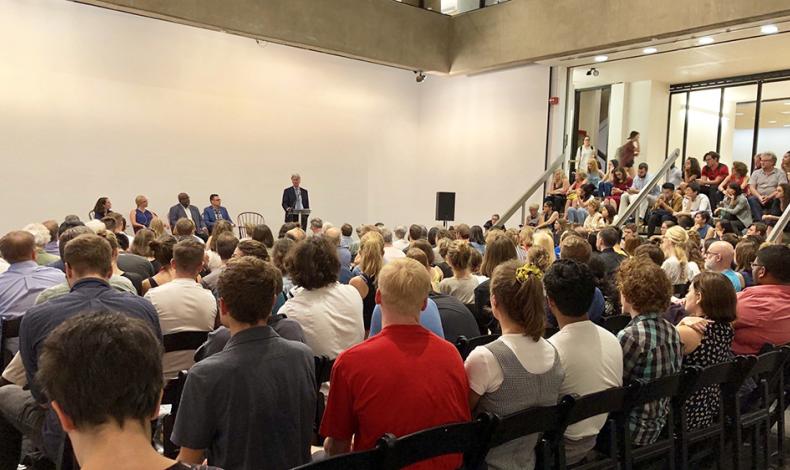McHarg Center Hosts Panel on Activism and Design

“Designing the Political Landscape.” a panel discussion including May Boeve, Billy Fleming, Wilks Family Director for the McHarg Center,Barbara Brown Wilson, an assistant professor of urban and environmental planning at the University of Virginia, and Mark Gardner (MArch’00), a principal at Jaklitsch / Gardner Architects and assistant professor of architectural practice and society at the Parsons School of Design at The New School.
May Boeve was a student at Middlebury College in Vermont when she started really thinking about climate change. And as her understanding of the scale of the threat evolved, so did her sense of how people could respond to it.
“It felt like this giant disconnect between a huge problem and not a lot of information about what we could do about,” Boeve told a Meyerson Hall audience for an August panel discussion on activism and design in the Trump era organized by The Ian L. McHarg Center for Urbanism and Ecology. “And it started to feel, eventually, like something we could actually change.”
She and her friends started with “symbolic gestures” like convincing the school to adopt more energy-efficient light bulbs, then moved on to demanding more substantial policy changes. Now, Boeve is executive director of 350.org, a leading global climate action group. Its name refers to the safe level of carbon in the atmosphere; today, the carbon level in the atmosphere is more than 400 parts per million. The organization’s name reflects the reality that humans have already done too much damage to the environment and need to make a “drastic course correction,” Boeve said. At 350, she’s working with others to reframe the climate movement to focus broadly on people and power relationships rather than more narrowly on things like threats to polar bears.
The McHarg Center’s fall event was called “Designing the Political Landscape.” In addition to Boeve, it featured Barbara Brown Wilson, an assistant professor of urban and environmental planning at the University of Virginia, and Mark Gardner (MArch’00), a principal at Jaklitsch / Gardner Architects and assistant professor of architectural practice and society at the Parsons School of Design at The New School. (Garder is also a PennDesign alumnus who serves on the School’s Board of Overseers.) A fourth scheduled panelist, Philadelphia City Councilwoman Helen Gym, was unable to attend the event.
Billy Fleming, Wilks Family Director for the McHarg Center, said after the event that the panel had been organized in response to growing student demands for more exposure to and engagement with the politics of design and planning. Those are tough things to teach in a traditional classroom or studio setting, Fleming said, and the McHarg Center wanted to provide an opportunity for that kind of conversation. It’s beginning to plan events for next spring and fall—book-ending its official summer launch event—that will draw on interdisciplinary research around climate change, with as broad a definition of what constitutes “research” as possible, Fleming said.
“Learning how to organize and join the movement-building that often drives our work has never been more relevant to design students and practitioners, yet few schools of design are thinking about how to bring those skills into a more conventional curriculum,” said Fleming. “This event was the McHarg Center's way of trying to foreground their necessity and to begin a broader conversation within and beyond the school about teaching and practicing activism through design.”
At the event, Brown Wilson talked about making the “tools of design” accessible to vulnerable populations. Often the needs and concerns of designers and planners are out of sync with realities in some disadvantaged communities, Brown Wilson said. For example, do-it-yourself, tactical urbanism has spread as a strategy for improving streetscapes and other public aspects of communities. But research has shown that those interventions aren’t equally possible everywhere; people of color tend to be much more policed for DIY interventions than white people, Brown Wilson said. Sometimes, empowering communities in the design process means de-centering the design professional, she said.
Gardner echoed that belief. When he left school he had a feeling that architecture could change the world, but as he entered professional life, he says he quickly realized there’s “no way that’s happening.” Through his practice, Gardner has design a lot of luxury interior spaces. In 2016, he completed a project for the benefit of a beekeeping community in Dodoma, Tanzania. That experience and others have shown him how design can contribute to social resilience—or not. He said he’s found hope that design has a role in improving the world, but only when architects work in partnership with communities.
“You’re going to have to accept that architecture isn’t always at the center of the conversation,” Gardner said.

